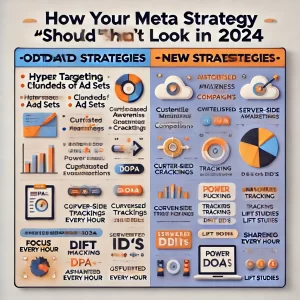2024 Meta Strategy
In the ever-evolving landscape of digital marketing, keeping up with the latest strategies is essential to stay ahead of the competition. As we move into 2024, it’s clear that many traditional tactics have become outdated. To help you stay current, here’s a comprehensive guide to what your Meta strategy should look like in 2024, and how it can significantly impact your marketing efforts.
Outdated Strategies: What to Leave Behind
Before diving into the new strategies, it’s important to recognize the methods that have become less effective:
- Hyper Targeting: While once effective, hyper-targeting can now lead to higher costs and diminishing returns due to privacy regulations and changes in ad algorithms.
- Hundreds of Ad Sets: Managing a vast number of ad sets is not only time-consuming but also inefficient. Streamlining your ad sets can improve performance and reduce complexity.
- Meta Pixel Tracking: With increasing privacy concerns and changes in browser policies, reliance on pixel tracking is diminishing.
- DPA’s with White Backgrounds: Generic Dynamic Product Ads (DPAs) lack creativity and fail to capture attention in a crowded digital space.
- Adjustments Every Hour: Constantly tweaking ads can lead to inconsistent performance and analysis paralysis. A more strategic approach is needed.
- Focus on ROAS: Return on Ad Spend (ROAS) is important, but an exclusive focus can overlook other critical metrics that contribute to long-term success.

Your Strategy in 2024: Key Components
To build a robust Meta strategy for 2024, consider incorporating the following elements:
1. Interest-Based Awareness Campaigns
Rather than hyper-targeting, focus on broader, interest-based campaigns. This approach helps to build brand awareness among a wider audience and aligns better with privacy-focused advertising.
2. Carefully Planned Creative
Invest time in developing high-quality, engaging creative that resonates with your audience. Thoughtful creative planning can significantly enhance ad performance and brand perception.
3. Clear Naming Conventions
Implementing clear and consistent naming conventions for your campaigns and ad sets makes tracking and analysis easier, leading to better optimization decisions.
4. Attribution Modelling
Utilize advanced attribution models to understand the full customer journey and the impact of each touchpoint. This helps in accurately assessing the effectiveness of your campaigns.
5. Power BI for Analysis
Leverage Power BI to analyze your data comprehensively. This powerful tool allows you to visualize trends, identify insights, and make data-driven decisions.
6. Whitelisted Creatives
Work with whitelisted creatives to ensure your ads maintain high quality and comply with platform guidelines, increasing their chances of approval and effectiveness.
7. Server-Side Tracking
With the decline of pixel tracking, server-side tracking offers a more reliable and privacy-compliant way to gather user data and measure campaign performance.
8. Customised DPAs
Move away from generic DPAs and create customized Dynamic Product Ads that reflect your brand’s unique style and capture your audience’s attention.
9. Sharing Post IDs
Sharing post IDs across campaigns can enhance social proof and engagement, as well as streamline the management of your social media assets.
10. Lift Studies
Conduct lift studies to measure the incremental impact of your campaigns. This provides a clearer picture of how your ads contribute to business outcomes beyond traditional metrics.
Additional Recommendations
To further enhance your Meta strategy in 2024, consider these additional tips:
- Integrate Omni-Channel Marketing: Coordinate your Meta strategy with other marketing channels to create a seamless customer experience and maximize reach.
- Focus on Customer Experience: Prioritize the user experience at every touchpoint, ensuring that your ads provide value and engage users meaningfully.
- Continuous Learning and Adaptation: Stay updated with the latest trends and continuously adapt your strategy based on performance data and industry developments.
- Enhanced Video Content: With the growing popularity of video, invest in creating high-quality video content that can be used across Meta platforms to drive engagement and conversions.
- AI and Automation: Utilize AI tools and automation to streamline your ad management processes, from creative optimization to bidding strategies.
Conclusion
The landscape of digital marketing is constantly shifting, and what worked yesterday might not be effective tomorrow. By embracing these updated strategies and focusing on innovative, data-driven approaches, you can ensure that your Meta campaigns remain impactful and relevant in 2024. Remember, the key to success lies in being adaptable and continuously refining your tactics based on performance insights and industry trends.
————————————————————————————————————————————————————————
Have a look at our case studies, you can see how we implement our knowledge onto our clients.


Hi there, I simply couldn’t leave your website without saying that I appreciate the information you supply to your visitors. Here’s mine Article Home and I cover the same topic you might want to get some insights about SEO.